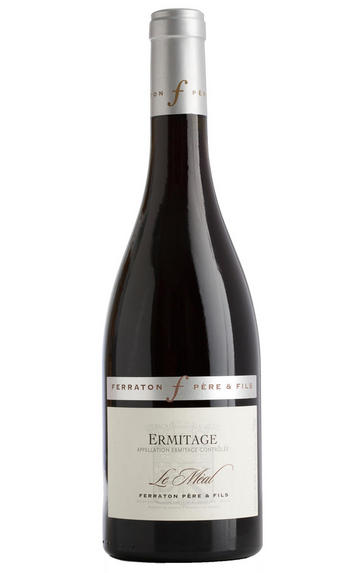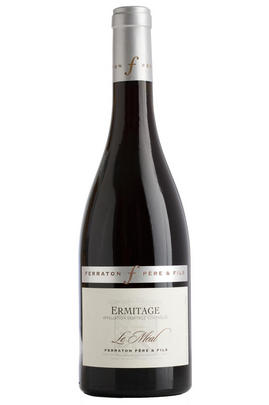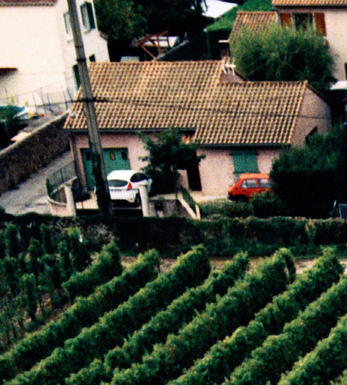
2014 Ermitage Rouge, Le Méal, Ferraton Père & Fils, Rhône

Critics reviews
Jeb Dunnuck - Wine Advocate - Issue#222 Dec 2015
About this WINE

Maison Ferraton
Maison Ferraton is a very fine Northern Rhône wine estate that was run for many years by Michel Ferraton. It is now run by Samuel Ferraton, the fourth generation of the family, who worked for a while in conjunction with Chapoutier frères. The firm has vineyard holdings in Hermitage and Crozes-Hermitage and its wine cellars are located immediately behind those of Marc Sorrel in the heart of Tain l`Hermitage.
Samuel Ferraton is very much an artisan winemaker- yet he employs many modern techniques that he picked up while working with the Chapoutiers.
Consequently, the wines are a marvellous marriage of the old and the new, displaying good structure and well-defined fruit characters, allied with very judicious and limited use of new oak. The wines are bottled unfined and unfiltered.

Hermitage
Hermitage is the most famous of all the northern Rhône appellations. The hill of Hermitage is situated above the town of Tain and overlooks the town of Tournon, just across the river. Hermitage has 120 hectares and produces tiny quantities of very long-lived reds.
The vines were grown in Roman times, although local folklore claims their origins to be nearly 600 years earlier. The name ‘Hermitage’ first appeared in the 16th century, derived from a legend of the 13th century Crusade, involving a wounded knight called Gaspard de Stérimberg, who made refuge on the hill, planted vines and became a hermit.
During the 17th century, Hermitage was recognised as one of the finest in Europe. In 1775, Château Lafite was blended with Hermitage and was one of the greatest wines of its day. In the late 19th century, however, Phylloxera wiped out all the vineyards.
The wines are powerful, with a deep colour and firm tannins, developing into some of the finest examples in France, with the potential to age for many decades. The best Hermitage is produced from several climats or more, blended together. The main climats are Les Bessards, Le Meal, L’Hermite, Les Greffieux and Les Diognieres. Most of the finest climats face broadly south, giving maximum sunshine. Most growers only have one or two climats and they might not complement each other; Hermitage quality can therefore vary hugely. Only the top producers have extensive diversified holdings.
80% of the wine produced is red, however up to 15% of white grapes can be used in the blend. Most growers use 100% Syrah and utilise the white grapes to make white wines only. Chapoutier, Jaboulet and Tain l'Hermitage are the principal proprietors of the appellation’s vineyards.
The white wines are made from the Marsanne and Roussanne grapes. Great white Hermitage can age, taking on the fruit characters of apricots and peaches, often giving a very nutty finish. The best examples in great vintages can last 50 years.
Mature red Hermitage can be confused with old Bordeaux. In a blind tasting of 1961 First Growth Clarets, the famous 1961 Hermitage La Chapelle was included. Most people, including its owner, Gerard Jaboulet, mistook it for Château Margaux.

Syrah/Shiraz
A noble black grape variety grown particularly in the Northern Rhône where it produces the great red wines of Hermitage, Cote Rôtie and Cornas, and in Australia where it produces wines of startling depth and intensity. Reasonably low yields are a crucial factor for quality as is picking at optimum ripeness. Its heartland, Hermitage and Côte Rôtie, consists of 270 hectares of steeply terraced vineyards producing wines that brim with pepper, spices, tar and black treacle when young. After 5-10 years they become smooth and velvety with pronounced fruit characteristics of damsons, raspberries, blackcurrants and loganberries.
It is now grown extensively in the Southern Rhône where it is blended with Grenache and Mourvèdre to produce the great red wines of Châteauneuf du Pape and Gigondas amongst others. Its spiritual home in Australia is the Barossa Valley, where there are plantings dating as far back as 1860. Australian Shiraz tends to be sweeter than its Northern Rhône counterpart and the best examples are redolent of new leather, dark chocolate, liquorice, and prunes and display a blackcurrant lusciousness.
South African producers such as Eben Sadie are now producing world- class Shiraz wines that represent astonishing value for money.


Buying options
Add to wishlist
Description
Le Méal is one of the better known parcels on the famous hill of Hermitage, its reputation being for wines of great power and elegance, the former taking 50% of new barrique ageing in its stride, the latter adding a typically silky mouth-feel to the cornucopia of red and black fruit. The 2014 is dense and richly extracted, with notes of leather and violet both evidenced and a whiff of a distant bonfire indulging us with gentle nostalgia.
Drink 2019-2024.
Simon Field MW, Wine Buyer
The 2014 vintage left the blocks with great speed, energised by a rainy winter which had topped up water reserves, and then by a dry and exceptionally mild spring. The pace calmed down thereafter, and thoughts of precocity eventually gave way to a relatively late harvest. Challenges were imposed by a mid-season which was by turns rainy and unseasonably cool, with rot a far from negligible danger and the somewhat unusual prospect of September being the warmest month of the year.
Not quite an Indian Summer, in point of fact, but warm enough to ensure timely ripening and a dry harvest. The whites have poise and finely etched fruit and the reds are balanced and approachable. Winemaker Damien Brisset, whilst acknowledging the challenges of the vintage, is more than pleased with the results. Careful to avoid over-extraction, he has allowed each commune and each lieu-dit to impose its personality on its wines and the results are impressive indeed.
wine at a glance
Delivery and quality guarantee